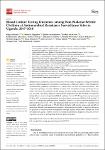| dc.contributor.author | Kisame, Rogers | |
| dc.contributor.author | Najjemba, Robinah | |
| dc.contributor.author | van Griensven, Johan | |
| dc.contributor.author | Kitutu, Freddy Eric | |
| dc.contributor.author | Takarinda, Kudakwashe | |
| dc.contributor.author | Thekkur, Pruthu | |
| dc.contributor.author | Delamou, Alexandre | |
| dc.contributor.author | Walwema, Richard | |
| dc.contributor.author | Kakooza, Francis | |
| dc.contributor.author | Mugerwa, Ibrahim | |
| dc.contributor.author | Sekamatte, Musa | |
| dc.contributor.author | Kimera, Robert | |
| dc.contributor.author | Katairo, Thomas | |
| dc.contributor.author | Opollo, Marc Sam | |
| dc.contributor.author | Otita, Morgan | |
| dc.contributor.author | Lamorde, Mohammed | |
| dc.date.accessioned | 2023-07-17T13:30:54Z | |
| dc.date.available | 2023-07-17T13:30:54Z | |
| dc.date.issued | 2021 | |
| dc.identifier.citation | Kisame, R., Najjemba, R., van Griensven, J., Kitutu, F. E., Takarinda, K., Thekkur, P., ... & Lamorde, M. (2021). Blood culture testing outcomes among non-malarial febrile children at antimicrobial resistance surveillance sites in Uganda, 2017–2018. Tropical Medicine and Infectious Disease, 6(2), 71. | en_US |
| dc.identifier.uri | https://doi.org/10.3390/tropicalmed6020071 | |
| dc.identifier.uri | http://ir.lirauni.ac.ug/xmlui/handle/123456789/733 | |
| dc.description.abstract | : Blood culture (BC) processes are critical to the utility of diagnostic testing, bloodstream
infection (BSI) management, and antimicrobial resistance (AMR) surveillance. While Uganda has
established BC guidelines, often laboratory practice does not meet the desired standards. This
compromises pathogen recovery, reliability of antimicrobial susceptibility testing, and diagnostic test
utility. This study assessed laboratory BC process outcomes among non-malarial febrile children be low five years of age at five AMR surveillance sites in Uganda between 2017 and 2018. Secondary BC
testing data was reviewed against established standards. Overall, 959 BC specimens were processed.
Of these, 91% were from female patients, neonates, infants, and young children (1–48 months). A
total of 37 AMR priority pathogens were identified; Staphylococcus aureus was predominant (54%),
followed by Escherichia coli (19%). The diagnostic yield was low (4.9%). Only 6.3% of isolates were
identified. AST was performed on 70% (18/26) of identified AMR priority isolates, and only 40% of
these tests adhered to recommended standards. Interventions are needed to improve laboratory
BC practices for effective patient management through targeted antimicrobial therapy and AMR
surveillance in Uganda. Further research on process documentation, diagnostic yield, and a review
of patient outcomes for all hospitalized febrile patients is needed.
Keywords: blood culture; bloodstream infections; febrile illness; antimicrobial resistance; antimicro bial susceptibility testing; operational research; SORT IT | en_US |
| dc.language.iso | en | en_US |
| dc.publisher | Tropical Medicine and Infectious Disease | en_US |
| dc.subject | blood culture | en_US |
| dc.subject | bloodstream infections | en_US |
| dc.subject | febrile illness | en_US |
| dc.subject | antimicrobial resistance | en_US |
| dc.subject | antimicrobial susceptibility testing | en_US |
| dc.subject | operational research | en_US |
| dc.subject | SORT IT | en_US |
| dc.title | Blood Culture Testing Outcomes among Non-Malarial Febrile Children at Antimicrobial Resistance Surveillance Sites in Uganda, 2017–2018 | en_US |
| dc.type | Article | en_US |

